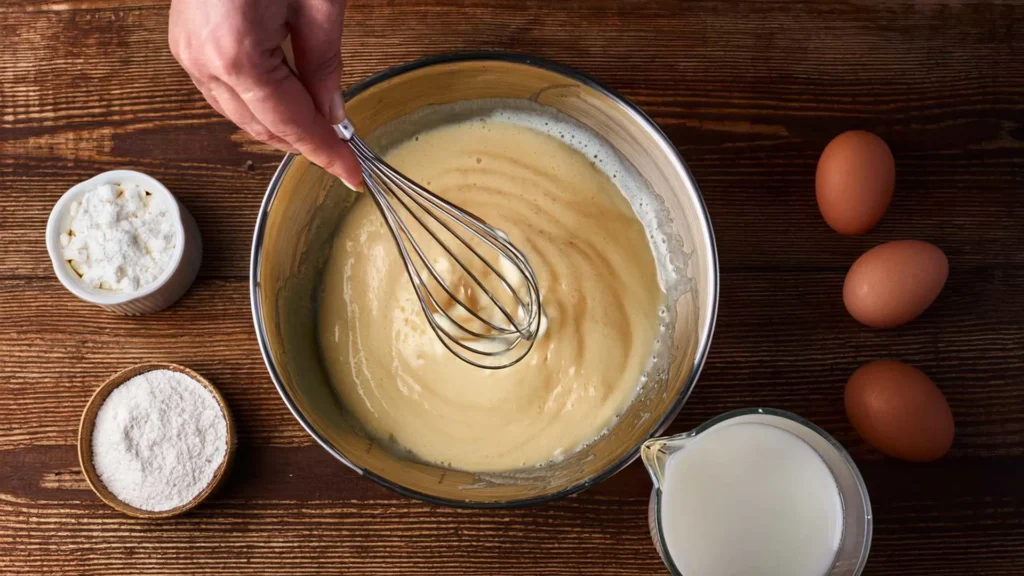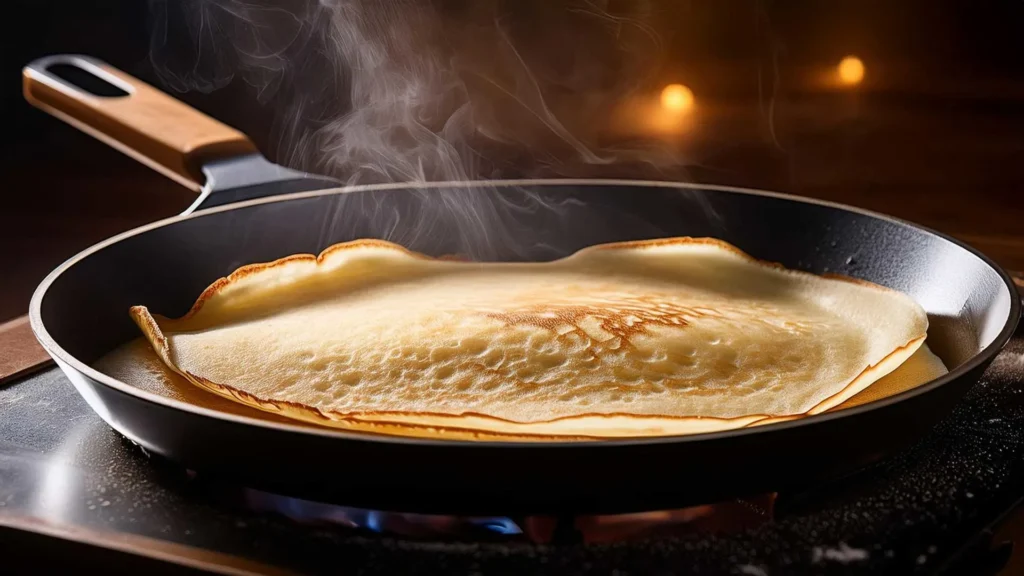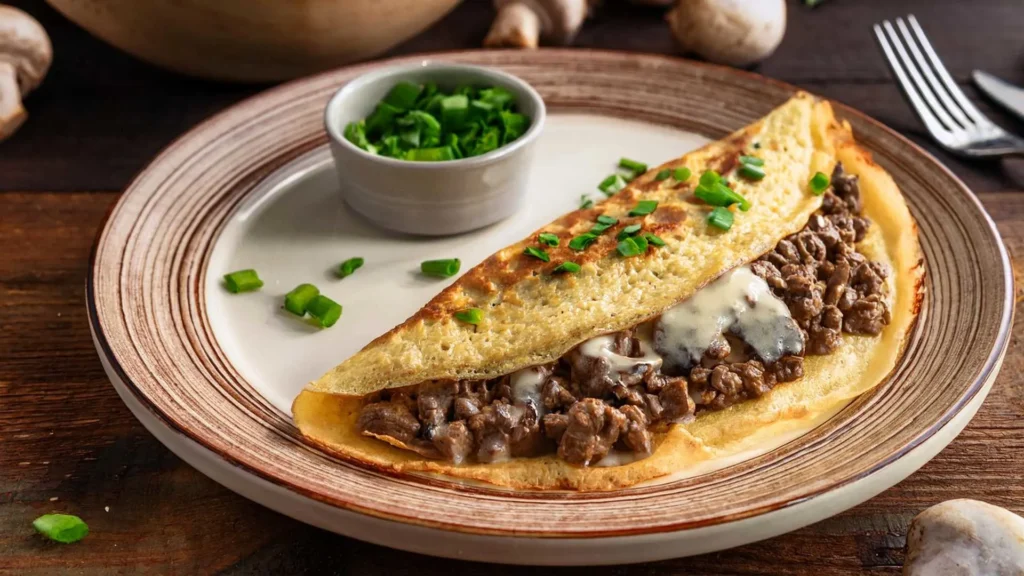Table of Contents
How to Make Crepas Fluffy and Light for a Perfect Dessert
1. What Are Crepas?
Crepas, or crepes, originate from France but have been adopted into cuisines worldwide, including Latin America where the term “crepas” is commonly used. Crepe fabric, with its unique texture, takes inspiration from the thin, delicate nature of these pancakes. The beauty of crepas lies in their versatility— they can be served plain, stuffed with cream cheese crepe filling, or turned into intricate dishes like a mille crepe cake.
2. The Science Behind Fluffy Crepas
To make crepas light and fluffy, consider the role of ingredients. A balanced mixture of eggs, flour, and milk ensures the right texture. Whisking the batter thoroughly helps incorporate air, which contributes to fluffiness. Allowing the batter to rest for 30 minutes aids in hydration and better binding of the flour, ensuring that each crepe comes out light and elastic.
3. Essential Ingredients for Perfect Crepes
To achieve perfectly balanced crepas, the following ingredients are key:
- Flour: All-purpose flour works best for standard crepas.
- Eggs: Essential for structure and richness.
- Milk: Whole milk creates a creamy consistency.
- Butter: Adds a silky texture and flavor.
- Sugar and Salt: Balance sweetness and enhance the flavor.
Tip: Using pancake mix as a shortcut can simplify the process. If you’re wondering how to make crepes using pancake batter, all you need to do is thin the batter with additional milk.
4. How to Make Crepas with Pancake Mix
If you’re looking for a quick solution, making crepas with pancake mix is surprisingly effective. Here’s how:

Ingredients:
- 1 cup pancake mix
- 1 1/2 cups milk
- 2 eggs
- 1 tbsp melted butter
Instructions:
- Combine pancake mix, eggs, and milk in a bowl. Whisk until smooth.
- Warm up an electric non-coated pan to the middle temperature and energetically lubricate it.
- Ladle a little of the batter into the pan spinning it around to coat the base.
- The pancakes should be brown from the underside when the edges of the pancake begin to curl up, then they have to be flipped over and cooked for another half a minute.
Pro Tip: For fluffy and flavorful results, use a higher milk-to-mix ratio and add a dash of vanilla.

5. Sweet Crepe Recipes to Try
a. Nutella Crepes
Spread Nutella on your crepas and fold them into quarters. Spoon the mixture over the top of the pie and then use another piping bag to put whipped cream on top for that extra special dessert.
b. Ricotta Berry Crepes

Fill crepas with a mixture of ricotta cheese and fresh berries for a refreshing dessert.
c. Mille Crepe Cake
Layer 20-25 crepas with cream or custard in between to create a mille crepe cake that’s perfect for special occasions.
d. 3 Ingredient Cottage Cheese Crepes

For a healthier version, blend cottage cheese, eggs, and a pinch of sugar for a simple, protein-packed filling.
6. Tips to Make Crepas Croccanti (Crispy)
To achieve crispy crepas or “creps,” follow these techniques:
- Use butter generously: Butter adds a crispy edge to crepas when cooked at the right temperature.
- Thin out the batter: Thinner batter results in crispier crepas.
- Cook on medium-high heat: This ensures a golden, slightly crispy surface.
These techniques will also help answer common questions like “come rendere le crepes croccanti” and “come rendere le creps croccanti.”
7. Savory Crepe Fillings

What goes in a meat crepe? Popular savory fillings include ground beef, mushrooms, and bechamel sauce. These savory crepas pair well with chutney or herbed butter.
8. Crepe Myrtle Care and Maintenance
Crepe myrtles are ornamental trees known for their vibrant blooms and resilience. Here’s how to care for them:
When Do Crepe Myrtles Bloom? These trees typically bloom in late spring to early summer, with flowers lasting until fall.
Trimming Crepe Myrtles Pruning is essential for shape and health. The ideal time for trimming is late winter before new growth begins.Succulent pruning is vulnerable to a weakened growth if it is done at the wrong time.
Crepe Myrtle Pruning Tips:
- Avoid cutting back too much, as it can cause “crepe murder,” a term referring to over-pruning.
- Use air pruning pots for young plants to promote healthy roots.
Dealing with Suckers on a Crepe Myrtle Remove suckers at the base to maintain tree shape and vigor.
Crepe Myrtle Diseases Common issues include powdery mildew and sooty mold. Regular cleaning and proper air circulation help prevent these diseases.
Crepe Myrtle Fall Care Apply mulch around the base for insulation and prune lightly to remove dead branches.
9. Common Questions About Crepas and Crepe Myrtles
Does Crepe Erase Really Work? “Crepe Erase” is a popular skincare product purported to reduce the appearance of crepey skin. Reviews are mixed; while some users report smoother skin, others question its efficacy. The “Crepe Erase lawsuit” highlighted some dissatisfaction with its advertising.
Crepe Bandage Uses Crepe bandages are used for medical support and compression in injuries. Their elasticity makes them suitable for treating strains or sprains.
Holy Crepe! Expressions like “Holy Crepe” and its use in pop culture, including mentions like “Guy Fieri’s DDD Holy Crepe caramel apple crepes,” have cemented crepes’ place as both a food and a cultural reference.
Creative Crepe Ideas and Garnishes For those looking to elevate their crepas, consider these unique ideas:
- Cocoa Crepe: Add cocoa powder to the batter for a chocolate-infused twist. Top with chocolate syrup and strawberries for an indulgent treat.
- Strawberry Crepe Cookie: Inspired by the flavors of strawberry shortcake, fill your crepas with sliced strawberries, whipped cream, and a touch of strawberry jam.
- Japanese Crepe: This street food favorite is often stuffed with a mix of fresh fruits, custard, and ice cream, and then folded into a cone shape for an on-the-go dessert.
Crazy Crepes at a Crepe Bar A modern trend is the crepe bar, where guests can customize their own crepas with various fillings and toppings. This is a great concept for parties or events where both sweet and savory options can be explored.
Crepe Calories and Nutritional Insights The calorie count of crepas can vary widely depending on the ingredients used. Plain crepas without fillings typically contain around 90-120 calories per piece. For comparison:
- Crepes with cream cheese filling: Approximately 200-250 calories, depending on portion size.
- Nutella crepes: Around 250-300 calories per serving, given the high sugar content.
- 3 ingredient cottage cheese crepes: This healthier option can range between 150-180 calories, with the added benefit of high protein content.
For health-conscious individuals, reducing the amount of sugar and opting for fillings like Greek yogurt and fruit can make crepas a lighter treat.
10. The Cultural Impact of Crepas
Crepas have a rich culinary tradition that spans cultures, from the elegant cafes of Paris to Latin American kitchens where “como hacen las crepas” is a common question passed down through generations. This universal love for crepas has inspired fusion dishes that blend local flavors with classic techniques.
The Crepe Incident: A playful term in food circles, “the crepe incident” can refer to any cooking mishap involving batter sticking to pans or folding disasters. It’s a reminder that practice makes perfect, and even seasoned chefs have had their share of kitchen blunders.
Holy Crepe and Pop Culture: The phrase “holy crepe” is used to express surprise and delight, showing how this beloved dish has transcended its culinary origins. Shows like Diners, Drive-Ins, and Dives (DDD) have featured standout dishes like “Holy Crepe Caramel Apple Crepes,” showcasing their popularity.
11. Advanced Crepe-Making Techniques

Sourdough Crepes: For a unique twist, use sourdough starter to make crepas. The fermentation process adds depth of flavor and a slight tanginess that pairs well with both sweet and savory fillings.
How to Make Crepes Dreamlight Valley Style Inspired by video game aesthetics, particularly life simulation games, these crepas are whimsical and vibrant, perfect for themed parties. Decorate with edible flowers, colorful fruit, and pastel icing for an eye-catching presentation.
12. Gardening with Crepe Myrtles
Crepe Myrtle Pruning Essentials Pruning crepe myrtles correctly ensures beautiful blooms and a healthy tree. Follow these guidelines:
- When is it best not to trim crepe myrtles?
Ideally, pruning should be done before new growth begins in late winter or early spring. Pruning in the summer can disrupt blooming and weaken the plant. - Crepe Myrtle Removal Costs:
- The cost of removing a mature crepe myrtle varies based on location and tree size but can range from $200 to $600. Ensure to consult with a certified arborist for accurate estimates.
Crepe Myrtle Bush with Clippings: When propagating crepe myrtles, clippings can be rooted to grow new plants. This method is cost-effective and allows for more crepe myrtles in your garden.
Air Pruning Pots and Crepe Myrtles: Using air pruning pots can promote a stronger root system by naturally “air pruning” the roots as they reach the container’s edge. This method prevents root circling and encourages healthier growth.
13. Common Issues with Crepe Myrtles
Dealing with Suckers on a Crepe Myrtle: Suckers are unwanted shoots that grow from the base of the tree. To remove them:
- Use sharp pruning shears to cut suckers as close to the base as possible.
- Regular removal prevents them from sapping energy from the main tree.
Crepe Myrtle Diseases and Solutions
- Powdery Mildew: A common fungal disease that appears as white, powdery spots on leaves. To prevent this, ensure proper spacing for air circulation and avoid overhead watering.
- Sooty Mold: Often a result of aphid infestations, sooty mold can be managed by controlling the insect population with neem oil or insecticidal soap.
Crepe Myrtle Fall Care: As the seasons change, preparing your crepe myrtles for winter involves mulching around the base to protect the roots from frost and avoiding heavy pruning to prevent exposure to the cold.
14. Unique Uses and Applications
Crepe Bandage and Its Benefits: Outside of the culinary and gardening spheres, “crepe” refers to elastic bandages used for support in injuries. Known for their stretch and flexibility, crepe bandages provide compression to sprained muscles and joints.
Crepe Erase: Does It Work? The skincare product Crepe Erase claims to improve the look of aging, crepey skin. While some users report noticeable results, the mixed reviews have led to consumer skepticism. The Crepe Erase lawsuit highlighted misleading advertising, urging users to manage expectations when using similar products.
Final Thoughts: A Journey Through Crepas and Crepe Myrtles
From crafting the perfect fluffy crepas to nurturing a blooming crepe myrtle tree, the world of “crepe” holds endless possibilities. Whether you’re savoring a warm Nutella crepe, layering a mille crepe cake, or meticulously pruning a crepe myrtle bush, these simple pleasures bring joy to our lives. Embrace the art and science behind these beloved traditions, and let your kitchen and garden flourish with creativity.
15. Celebrating Crepe Culture in Festivals and Traditions
Crepas and crepe myrtles each hold unique places in cultural celebrations around the world. Understanding these connections can add a layer of appreciation to your culinary and gardening experiences.
Crepe Day (La Chandeleur): In France, February 2nd is known as “La Chandeleur,” or Crepe Day. It is a tradition to make and eat crepes as a symbol of prosperity and good fortune. Legend has it that if you flip a crepe in the pan with one hand while holding a gold coin in the other, your year will be prosperous.
Crepe Festivals Around the World: Many regions celebrate their own versions of crepe festivals. For example, Brittany, France, known as the birthplace of crepes, hosts numerous events featuring crepes in all forms. From savory galettes made with buckwheat to sweet dessert crepes, these festivals showcase local culinary talent and traditions.
Gardening Festivals Featuring Crepe Myrtles: In the southern United States, where crepe myrtles are a common and cherished sight, community events often highlight these beautiful trees, especially in the peak of summer when they bloom. Garden tours and local festivals may include lectures on proper pruning, maintenance, and the diverse varieties of crepe myrtles that thrive in different climates.
16. Incorporating Crepes and Crepe Myrtles in Your Lifestyle
For those passionate about incorporating both culinary art and horticulture into their lives, consider these creative ideas:
Host a Crepe Brunch: Set up a crepe-making station for friends and family with a variety of fillings and toppings. This interactive experience not only showcases your crepe skills but allows guests to customize their own crepe creations.
Garden Party Featuring Crepe Myrtles: If you have crepe myrtles in your yard, a garden party during their peak bloom season can be a stunning event. Use garden furniture, string lights, and floral centerpieces to create a serene and inviting atmosphere. Serve crepas as an elegant snack to tie the theme together.
DIY Crepe-Infused Gifts: Homemade jars of crepe batter mix paired with a recipe card make excellent gifts. Add a small container of a unique topping, such as homemade chocolate-hazelnut spread or berry compote, for a personal touch.
Crepe Myrtle Décor: Use crepe myrtle branches in floral arrangements or as table centerpieces. The flowers’ vibrant hues can add a burst of color to any setting. For a natural and rustic aesthetic, dried crepe myrtle seed pods can be incorporated into wreaths or seasonal decorations.
17. Troubleshooting Common Problems
Whether it’s your crepas not turning out as expected or issues with your crepe myrtles, these troubleshooting tips will help:
Why Are My Crepas Chewy?
- Solution: Chewy crepas often result from overmixing the batter. Mix just until the ingredients are combined, and let the batter rest for 30 minutes before cooking. This allows the gluten to relax, ensuring a tender texture.
Why Aren’t My Crepe Myrtles Blooming?
- Solution: This issue can arise from inadequate sunlight or improper pruning. Ensure that your crepe myrtle receives full sun and avoid pruning during the growing season, as this can remove flower buds.
My Crepas Keep Sticking to the Pan
- Solution: Make sure your pan is non-stick and well-heated before adding batter. Using a bit of melted butter or cooking spray can also help prevent sticking.
Crepe Myrtle Has Powdery Mildew
- Solution: Powdery mildew can be managed by ensuring proper air circulation around the plant. Trim back any overcrowded branches and apply a fungicidal treatment if necessary.
18. Fun Facts and Trivia
- Crepe Origins: The word “crepe” comes from the Latin word crispa, meaning “curled,” which hints at the delicately curled edges of perfectly cooked crepas.
- Crepe Myrtle Lifespan: Crepe myrtles can live for decades, with some specimens known to last up to 50 years or more when properly cared for.
- World Record Crepe: The largest crepe ever made measured over 15 meters in diameter and weighed approximately 3,000 kilograms.
- Symbolism: In the language of flowers, crepe myrtles are often associated with longevity and good fortune, making them a popular choice for planting near homes.
19. Embracing the Art of Crepe-Making and Crepe Myrtle Cultivation
Whether you’re perfecting your favorite crepa recipe or cultivating a flourishing garden filled with crepe myrtles, these activities foster a sense of accomplishment and joy. By combining skill, patience, and creativity, both pursuits provide endless opportunities for growth and expression.
Conclusion
Embarking on a journey with crepas and crepe myrtles can transform ordinary moments into extraordinary ones. Experiment with different flavors and techniques in your kitchen or try growing new varieties of crepe myrtles to diversify your garden. Both experiences allow you to celebrate tradition, culture, and nature, enriching your life with beauty and flavor.
Whether mastering the art of making crepas or maintaining your crepe myrtle trees, understanding these fundamentals will enrich your culinary and gardening endeavors. From sweet delights like Nutella crepes to detailed care tips for crepe myrtles, there’s always more to explore and enjoy. Whether you’re saying “holy crepes” over a perfect bite or tending to your crepe myrtle, let these insights guide your journey to expertise.







1 thought on “How to Make Crepas Fluffy and Light for a Perfect Dessert”
Comments are closed.